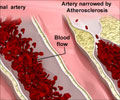Scientists from the Institute of Molecular and Cell Biology (IMCB) and the Singapore Bioimaging Consortium (SBIC) have discovered a new signalling pathway that controls both obesity

The team demonstrated, for the first time, that mice deficient in the Wip1 gene were resistant to weight gain and atherosclerosis via regulation of the Ataxia telangiectasia mutated gene (ATM) and its downstream signalling molecule mTor.
Obesity and atherosclerosis-related diseases account for over one-third of deaths in the Western world. Controlling these conditions remains a major challenge due to an incomplete understanding of the molecular pathways involved.
Atherosclerosis, a progressive disease of the large arteries, is an underlying cause of many cardiovascular diseases.
Obesity and atherosclerosis are accompanied by the accumulation of lipid droplets in adipocytes (fat cells) and in foam cells respectively. Foam cells can subsequently rupture, damaging blood vessels, and contributing to further progression of atherosclerosis.
The scientists discovered that Wip1 deficient mice, even when fed a high-fat diet, were resistant to obesity and atherosclerosis by preventing the accumulation of lipid droplets. This appeared to be through increased autophagy, the normal process by which the body degrades its own cellular components.
Advertisement
"This is the first time that Wip1-dependent regulation of ATM-mTor pathway has been linked to authophagy and cholesterol efflux thus providing an entirely new avenue for treatment of obesity and atherosclerosis," said Dr Dmitry Bulavin, Senior Principal Investigator at IMCB and lead author of this paper.
Advertisement
Dr Dmitry Bulavin said, "We are building on this research to investigate if the same mechanism could also control tumour progression and hence potentially unlock new therapeutic treatments targeting Wip1, ATM and mTor in cancer as well and the preliminary results are promising."
This discovery also adds to the growing significance of ATM as an important gene with a key role in protecting us from major pathological conditions.
"This is the first time that these important molecules have been integrated into a linear pathway that plays a prominent role in controlling obesity and atherosclerosis. It is a fine example of how fundamental research can shed light on biological and medical questions to potentially open new avenues of formulating therapeutic strategies for the benefit of patients," Prof Hong Wanjin, Executive Director of IMCB, said.
The findings were published in the journal Cell Metabolism on 3rd July.
Source-ANI














